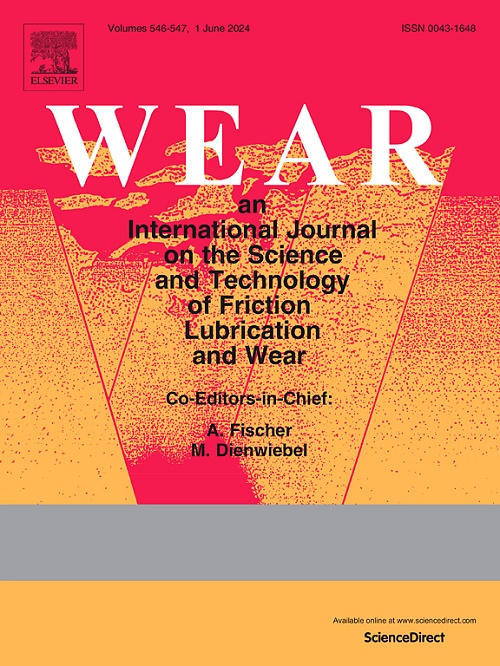AlNbTiVSi0.1 lightweight refractory high-entropy alloy coating by GTA cladding: microstructural evolution and high-temperature wear mechanism exploration
IF 5.3
1区 工程技术
Q1 ENGINEERING, MECHANICAL
引用次数: 0
Abstract
The excellent properties of Ti-6Al-4V (TC4) alloy make it highly suitable as a structural component in the aerospace field. The limited wear resistance of TC4 alloy at high temperature restricts its use in high-temperature environments. To enhance the high-temperature wear resistance of TC4 alloy and broaden its application range, we used gas tungsten arc cladding to fabricate an AlNbTiVSi0.1 lightweight refractory high-entropy alloy coating (LRHEAc) on TC4 alloy for the first time. The microstructure, hardness, and high-temperature wear resistance of LRHEAc were analyzed. The LRHEAc was composed of BCC, Ti-Nb, and (Nb, Ti)5Si3 phases. The hardness of the top of LRHEAc reached 821.39 Hv0.5, which was 2.36 times higher than that of TC4 alloy. At room temperature, 200 °C, 400 °C, and 600 °C, the LRHEAc exhibited excellent wear resistance compared to the TC4 alloy. The LRHEAc transitioned from fatigue and abrasive wear at room temperature to oxidative wear at high temperature. At different temperatures, the mass wear rate of LRHEAc friction disc was 2.29–2.59 times higher than that of TC4 alloy, while the mass wear rate of LRHEAc itself decreased by 3.73–4.65 times compared to TC4 alloy. Within the wear system formed by both materials, the overall wear rate of LRHEAc was enhanced by 8.7–10.6 times compared to TC4 alloy. The Si element in the LRHEAc promoted the sintering of wear debris on the coating's wear surface at high temperature, forming a dense and strong wear-resistant oxide layer, significantly reducing the friction coefficient and mass wear rate.
GTA熔覆AlNbTiVSi0.1轻质难熔高熵合金涂层:显微组织演变及高温磨损机理探讨
Ti-6Al-4V (TC4)合金的优异性能使其非常适合作为航空航天领域的结构部件。TC4合金在高温下有限的耐磨性限制了其在高温环境中的使用。为了提高TC4合金的高温耐磨性,拓宽其应用范围,首次在TC4合金表面采用气体钨弧熔覆法制备了AlNbTiVSi0.1轻质耐火高熵合金涂层(LRHEAc)。分析了LRHEAc的显微组织、硬度和高温耐磨性。LRHEAc由BCC、Ti-Nb和(Nb, Ti)5Si3相组成。LRHEAc合金的顶部硬度达到821.39 Hv0.5,是TC4合金的2.36倍。在室温、200°C、400°C和600°C下,与TC4合金相比,LRHEAc表现出优异的耐磨性。LRHEAc由室温下的疲劳磨损和磨粒磨损过渡到高温下的氧化磨损。在不同温度下,LRHEAc摩擦片的质量磨损率比TC4合金高2.29-2.59倍,而LRHEAc本身的质量磨损率比TC4合金降低了3.73-4.65倍。在两种材料形成的磨损系统中,LRHEAc的整体磨损率比TC4合金提高了8.7-10.6倍。LRHEAc中的Si元素在高温下促进磨损屑在涂层磨损表面的烧结,形成致密、强耐磨的氧化层,显著降低摩擦系数和质量磨损率。
本文章由计算机程序翻译,如有差异,请以英文原文为准。
求助全文
约1分钟内获得全文
求助全文
来源期刊

Wear
工程技术-材料科学:综合
CiteScore
8.80
自引率
8.00%
发文量
280
审稿时长
47 days
期刊介绍:
Wear journal is dedicated to the advancement of basic and applied knowledge concerning the nature of wear of materials. Broadly, topics of interest range from development of fundamental understanding of the mechanisms of wear to innovative solutions to practical engineering problems. Authors of experimental studies are expected to comment on the repeatability of the data, and whenever possible, conduct multiple measurements under similar testing conditions. Further, Wear embraces the highest standards of professional ethics, and the detection of matching content, either in written or graphical form, from other publications by the current authors or by others, may result in rejection.
 求助内容:
求助内容: 应助结果提醒方式:
应助结果提醒方式:


